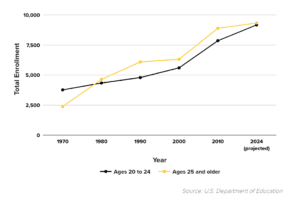On the Front Lines of Adult Education? We Want to Hear From You!
We’re going to be spending more time in this space discussing the needs of adult learners, how they differ from traditional students, and how institutions can evolve to accommodate this diverse population. In the coming weeks, stay tuned for a series of posts, articles and white papers that address what institutions of all types — from small privates to large publics — can do to attract these students, to help them persist and to graduate them as lifelong learners.
“Discussing” is the operative term here. The collective wisdom of our community of practice will propel this dialog. The collective we— Abound, our members and our readers — want to hear from everyone on the front lines about what’s working to help more post-traditional learners thrive in college and afterward. Consider this your standing invitation to comment, email us with ideas, provide guest posts, etc. Collaborative learning isn’t just for traditional undergraduates.
EducationDive posted an interesting snapshot of this group that should stoke some conversation about this segment’s growth and the diversity of its needs:
“The profile of the college campuses has changed dramatically over the last decade with an influx of students from more diverse socioeconomic, gender and ethnic backgrounds — so much so that the industry term ‘nontraditional’ is now really just the new traditional. But in addition to these characteristics, the average age of the college students is also increasing, with more adult learners coming to campus, with data showing the adult learner populations will increase tremendously over the next nine years.”

For a variety of reasons, many colleges are trying to extend their missions to address this learner segment.
For small colleges, doing so will pressure-test a long-perceived strength — their consistent, personalized approach — by applying it to adult learners’ demands for flexible schedules, multi-modal curricula, accelerated degree and alternative credentialing options, online classes and technological integration.
For colleges competing with the online Goliaths, there is a huge opportunity to take advantage of perhaps their most sustainable differentiator: their local name recognition. Adult learners, perhaps much more so than traditional students, care deeply about earning a marketable credential from an institution nearby employers recognize favorably.
The challenge for each institution is primarily one of product/market fit: What programs and competencies do local employers and prospective students value the most? What support services should institutions invest in to support adult learners’ persistence and graduation? What’s the appropriate mix of on-ground, hybrid and online course offerings? In fact, these are some of the things we’ve discussed in our comprehensive guide detailing how to forge organizational partnerships to increase adult student enrollment.
Indeed, we’re fast approaching the point where it may be time to stop thinking of this segment as one segment, but as combinations of several: veterans, active military, parents, full-time employees, etc. The mix of these segments varies by market, so look critically at best practices: What’s successful in Philadelphia may miss the mark in San Antonio.
These distinctions have huge implications for an institution’s services. For example, the scope of Career Services is broader and more nuanced when serving students who are either climbing an existing career ladder or switching careers, as opposed to just starting out. The implications are similarly dramatic for financial aid, advising, course scheduling, enrollment, etc.
At many institutions, serving adult learners can feel like lonely work. At a school that has historically catered to the traditional, 18-22-year-old student, those tasked with developing and marketing an adult program can feel dwarfed by the number of staff and faculty devoted to the traditional students.
If you’re one of those fearless few, you’re competing for resources, budget and leadership focus with a part of the institution that has been the unquestioned breadwinner for sometimes more than a century.
We’re going to be unpacking all of these themes and more, tapping into the collective wisdom of our members, advisors and beyond to provide a steady stream of resources and insights. Along the way, we’re inviting you to join us in the conversation. Please share your experiences, questions, suggestions, criticisms, so that we can all learn together!
[bsa_pro_ajax_ad_space id=3]


